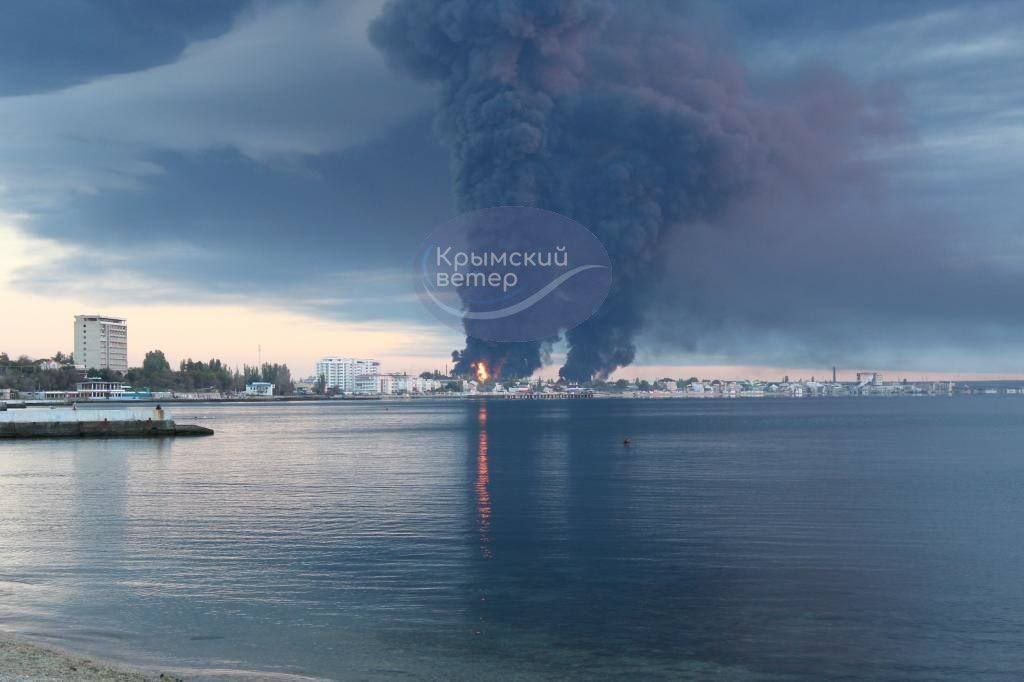A major oil refinery in Crimea has been burning for three days following a successful Ukrainian drone strike on October 7, severely impacting the region’s energy infrastructure. The attack targeted the largest fuel storage facility in the port city of Feodosia, a critical asset for Russian military operations.
According to the General Staff of the Ukrainian military, its forces launched the strike, which led to a series of explosions and widespread damage at the JSC Marine Oil Terminal in southeastern Crimea.
The depot, vital for Russian military logistics, has continued to burn, with videos and images showing flames and thick smoke rising high into the sky.
On the day of the attack, residents in the city of Feodosia reported hearing a series of powerful explosions following the attack, with some claiming they heard aircraft engine noises before that.
Social media posts from the area documented the fire, showing large plumes of smoke visible from miles away. Although some residents mentioned hearing just three loud blasts without any accompanying aircraft noise, the force of the strike was unmistakable.

Initially, Crimean authorities downplayed the severity of the incident. In a public statement, officials said that the situation was “under control” and that something had merely “caught fire” at the oil refinery.
Feodosia’s Mayor, Igor Tkachenko, reassured residents that there were no casualties and that firefighters had contained the blaze. However, updates on October 9 indicated that the situation had worsened significantly.
Reports from the pro-Ukrainian Telegram channel Crimean Wind and Petro, Andriushchenko, an advisor to the mayor of Mariupol, revealed that the fire had continued for three days after the strike.
Two additional fuel tanks exploded, exacerbating the already severe fire. According to satellite imagery published by Radio Liberty, at least ten fuel tanks were burning on October 8, further confirming the extent of the damage.
The Krymskiy Vetr Telegram channel stated that there had been explosions involving gasoline and kerosene tanks, with kerosene likely contributing to the ongoing light smoke rising from the location.
Russian experts from the Emergency Situations Ministry stated that the fire could continue for several days, as it would be impossible to extinguish until all the fuel had burned out.
Major Blow To Russia?
The extended fire at Feodosia’s oil depot marks a major blow to Crimea’s infrastructure, already under pressure from previous strikes. This latest attack exposes the vulnerability of key Russian assets in the area while highlighting the increasing effectiveness and reach of Ukrainian military operations.
Ukraine’s General Staff said that the oil terminal in Feodosia, situated on Crimea’s southern coast, plays a critical role in supplying fuel to the Russian army.
They explained that the strike was part of a broader effort to degrade Russia’s military capabilities and economic strength. This action is aligned with Ukraine’s ongoing strategy to undermine the Russian Federation’s military and economic potential.
The JSC Marine Oil Terminal in Crimea is the largest oil and gas processing facility in a highly militarized region housing Russian naval, air, and ground forces.
The Crimean Peninsula is home to just two key oil terminals, one of which is located in Sevastopol, another area under intense contention and temporarily controlled by Russia. The destruction of such critical infrastructure increases Russia’s logistical challenges.

Since it invaded Ukraine in February 2022, Russia has faced ongoing challenges in maintaining steady supply lines to Crimea.
The peninsula is connected to mainland Russia primarily through vulnerable rail and sea routes, which have been intermittently attacked by Ukrainian forces. This makes the region’s supply chain susceptible to disruption, making facilities like Feodosia’s oil terminal even more critical.
The Feodosia terminal processes fuel and is a crucial hub for the regional transshipment of petroleum products. According to the independent Russian news outlet Astra, the facility boasts a storage capacity of 250,000 tons, underlining its significance in military and civilian supply chains.
A sustained halt in terminal operations could result in widespread fuel shortages, affecting the Russian military stationed in Crimea and the local civilian population.
This isn’t the first time that the Feodosia facility has been targeted. In March 2024, Ukrainian drones successfully damaged the main fuel pumping pipeline, which led to an immediate 20% spike in retail fuel prices.
Such disruptions would undeniably strain military logistics and daily civilian life. On the other hand, the ongoing attacks on critical infrastructure like Feodosia’s oil depot are central to Ukraine’s broader military strategy.
- Contact the author at ashishmichel(at)gmail.com
- Follow EurAsian Times on Google News




